Dennistoun: No Mean Streets
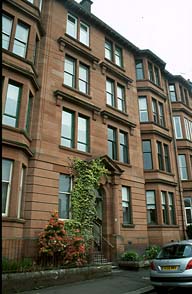 The district of Dennistoun is an island. Not only is it physically situated on rising ground above Townhead, Brigton and Parkhead, but it was, and remains, socially an island of unfliniching respectability in the surrounding East End of Glasgow. For many working class folk in that part of the town, Dennistoun was the summit of their social ambitions. While socialist activists on Glasgow Green hoped to lead the working classes to the promised land, most of them would just have settled for Dennistoun.
The district of Dennistoun is an island. Not only is it physically situated on rising ground above Townhead, Brigton and Parkhead, but it was, and remains, socially an island of unfliniching respectability in the surrounding East End of Glasgow. For many working class folk in that part of the town, Dennistoun was the summit of their social ambitions. While socialist activists on Glasgow Green hoped to lead the working classes to the promised land, most of them would just have settled for Dennistoun.
The Glasgow singer Lulu moved to Dennistoun as a girl from Brigton, and said: ( I Don't Want to Fight),
'When we moved from Soho Street across the railway bridge to Garfield Street, it was only a couple of hundred yards, but mentally it was a lot further. We had edged slightly up in the world because we now lived closer to Duke Street and further away from the Gallowgate. There weren't so many poorly dressed kids or runny noses.'
Andrew Stewart dedicated a book of photographs of the area, Old Dennistoun, to his parents whom, of whom he says that they, "had one of their hopes fulfilled when we moved house from Townhead to Dennistoun." Like Lulu, he had moved a very short distance, but into an area that signified an important step up the social ladder. A mark of its social status and respectability is that until the 1960s, in a city renowned for its alcohol abuse, the Dennistoun area was "dry".
But had things developed differently, Dennistoun would not be a by-word for working class respectability, but instead a residential area for the upper and middle classes to rival Glasgow's West End. Alexander Dennistoun was from a Glasgow banking family, and in 1856 he engaged the renowned Victorian architect James Salmon to plan and lay out a residential suburb called after him. Only a few streets were built in the 1860s and 1870s, before the spread of the heavy industries roundabout caused the plan to be aborted. Tucked away between Duke Street and Alexandra Parade, the villas and terraces which remain from Salmon's grand design are one of the little known treasures of Glasgow.
In 1872 John Tweed's Guide to Glasgow and the Clyde had this area very definitely on the tourist itinerary, recommending a walk to "the pleasant suburb of Dennistoun. It is well laid out and contains many fine villas and lodges. The approach by Alexandra Parade is very fine."
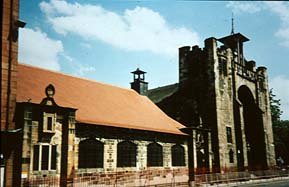 The area was subsequently feued for the building of tenements from the 1880s, although of a quality generally much higher than the rest of the East End. At first these were expected to attract middle class tenants, but by 1914 Dennistoun had instead become the residential location of the aristocracy of the working class.
The area was subsequently feued for the building of tenements from the 1880s, although of a quality generally much higher than the rest of the East End. At first these were expected to attract middle class tenants, but by 1914 Dennistoun had instead become the residential location of the aristocracy of the working class.
And Dennistoun had had another false start before finding its identity, being a location of one of the birthplaces of the industrial revolution. In the 1770's George Macintosh, in partnership with David Dale of New Lanark, established a factory in Dennistoun, to the east of the present Necropolis. This was set up to produce cudbear, a dye for the textile industry. As well as the factory built a model village for his workers, with housing and educational facilities. The roll call at the Dunchattan works every morning was in Gaelic, for Macintosh employed only Gaelic speakers. The reason for this was not that the Highlanders had a good reputation as hard workers (on the contrary) but that being Gaelic speakers, and being discouraged from communicating with people from outwith the settlement (he even surrounded the factory with a high wall), Macintosh hoped to be able to protect his industrial secrets from competitors.
George's son Charles continued the business and experimented in industrial chemistry, having taken classes with Joseph Black at Glasgow University. He discovered that ammonia, in the form of naptha, a by-product to the making of his cudbear, would dissolve rubber. This gave birth to the waterproofing of textiles, and the dubbing of such garments as "mackintoshes". Shortly before his death in 1843, Macintosh moved the works to Manchester and Dennistoun's contribution to industrial progress ceased, for it never gain became a centre of industry. This period is however commemorated in the naming of the 1970's and 80's housing at Dunchattan Street and Macintosh Court, on the site of the former works.
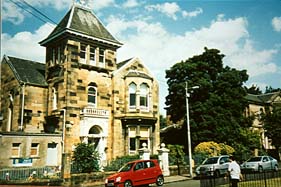 After this experiment ended, people tended to live in Dennistoun, but not to work in it. For, unlike many of the other areas of Glasgow where housing and manufacturing were in close proximity, industry was located at the edges of Dennistoun. To the east lay the chemical works, to the south the slaughterhouse, and to the north the steelworks and gasworks separated from Dennistoun by the Monklands Canal. All firmly outwith the residential streets of the area. Later, Alexandra Parade became the centre of Glasgow's cigarette industry and was awarded the name Tobacco Road. But even there, you were past the factories before you arrived at the tenement buildings. With its lack of industry and its good housing, it is easy to understand why so many in Calton or Camlachie looked enviously uphill at the denizens of Dennistoun.
After this experiment ended, people tended to live in Dennistoun, but not to work in it. For, unlike many of the other areas of Glasgow where housing and manufacturing were in close proximity, industry was located at the edges of Dennistoun. To the east lay the chemical works, to the south the slaughterhouse, and to the north the steelworks and gasworks separated from Dennistoun by the Monklands Canal. All firmly outwith the residential streets of the area. Later, Alexandra Parade became the centre of Glasgow's cigarette industry and was awarded the name Tobacco Road. But even there, you were past the factories before you arrived at the tenement buildings. With its lack of industry and its good housing, it is easy to understand why so many in Calton or Camlachie looked enviously uphill at the denizens of Dennistoun.
Dennistoun's position as the area's jewel in the crown was recognised when it was chosen to stage both the East End Industrial Exhibitions, that of 1890-91 and the subsequent one in 1903-4; 750,000 attended the first and over a million the second. The first raised £3000 for the building of the People's Palace, which many expected would be in Dennistoun's Alexandra Park, but was instead placed on Glasgow Green The educational exhibits drew crowds, but the main event was the "Buffalo Bill" Wild West Show, starring Colonel Cody himself. Dennistoun was later to produce many characters in the world of entertainment to rival Buffalo Bill. A statue commemorates Buffalo Bill's visit in a new block of flats just off Whitehill Street.
Which brings us back to Lulu. Let us start, as she did, with a railway crossing. The train today deposits the traveller at Bellgrove Station and on exiting, to the left is Brigton , literally on the wrong side of the tracks. To the right across the railway bridge which Lulu saw a social marker, is Dennistoun. On crossing Duke Street, and heading up Westercraigs, you are in the heart of what was actually executed of Salmon's plans for a grand suburb. Salmon himself originally lived here, and so too did Sir William Arrol, who opened his Dalmarnock Iron Works in Brigton in 1868, and who is best remembered for the construction of the Forth Bridge in 1890. It should be remembered that in the 1860s the University was still in the nearby High Street, less than a mile away; its move westwards was a fatal blow to Salmon's great plans.
At the bottom of Westercraigs is Annfield Place, terraced houses formerly occupied by lawyers, doctors and engineers- and now the location of the offices of the same professions, since these people don't live in Dennistoun, respectable though it is. But once off Duke Street such terraces replicate themselves and are still quality housing, with the larger villas on the left. At the top of the hill is the delightful Broompark Circus. Hereabouts it is really hard to believe that you are in Glasgow's East End. Just north of this area were the tobacco factories, and some of the land abandoned is being developed for modern quality housing. Gentrification is nibbling at the edges of Dennistoun.
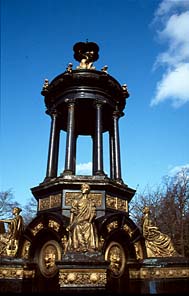 Glasgow's connection with tobacco goes back to the eighteenth century and the Tobacco Lords, who make their wealth from the trade in the weed with the American colonies. The cigarette industry was a much later development, making the fortunes of such as Stephen Mitchell, whose legacy endowed the Mitchell Library in the city. One of his factories was located at Alexandra Parade, and is now refurbished as a collection of studios, the Wasp Factory, for arts workers. Next to it stands the Players' factory, an imposing, though rather late example of Art Deco completed in the early 1950s. This too has ceased cigarette production and was refurbished as a business centre for high tech and advertising firms. Today Glasgow's only connection with tobacco lies sadly in its continued high consumption by its citizens of cigarettes, and the consequent high mortality rates.
Glasgow's connection with tobacco goes back to the eighteenth century and the Tobacco Lords, who make their wealth from the trade in the weed with the American colonies. The cigarette industry was a much later development, making the fortunes of such as Stephen Mitchell, whose legacy endowed the Mitchell Library in the city. One of his factories was located at Alexandra Parade, and is now refurbished as a collection of studios, the Wasp Factory, for arts workers. Next to it stands the Players' factory, an imposing, though rather late example of Art Deco completed in the early 1950s. This too has ceased cigarette production and was refurbished as a business centre for high tech and advertising firms. Today Glasgow's only connection with tobacco lies sadly in its continued high consumption by its citizens of cigarettes, and the consequent high mortality rates.
Alexandra Parade is a pleasant street of solid tenements, with neat gardens on the north side and neat shops on the south, which leads to Alexandra Park. Outside is found a good example of Glasgow iron work, a fountain beside the park gates. But if this impresses, you are in for a greater delight. Inside the park can be found possibly the finest example of the work of the Saracen Iron Foundry still to be seen in Glasgow. Walter Macfarlane built this at Possil, and exhibited it at the 1901 International Exhibition; thereafter it was relocated to the park, and it has recently been restored. The classical figures represent Art, Literature, Science and Commerce.
I was taking some photographs, and got into conversation, as is often unavoidable in Glasgow. A local, obviously proud of the fountain, told me that there used to be fish in it, and that as a kid he would come and catch them.
"It's disgraceful," he added "There should still be fish in it."
"Maybe if you hadn't kept catching them, there still would be?" I suggested.
Alexandra Park was opened in 1870, supposed to be an East End equivalent of the West End's Kelvingrove, a polite watering place. The westward flight of the middle classes has left the folk of Dennistoun with a huge area for recreation, and a very fine park.
Formerly the inhabitants, and especially the weans, had more exciting attractions. Before the motorway the Monklands canal separated Dennistoun from the city to the north, and the canal banks were a favourite recreational spot, especially the waterfall at Riddrie Locks, which flowed once the locks became derelict. Further on at Riddrie Knowes were the Sugerolly Mountains, multi coloured chemical deposits where the kids would go sledging in winter, doubtless at great but unknown threats to their health.
Just after the park gates lies the former United Free Church built in 1904, and whose hall was designed by James Salmon 11, grandson of the original Dennistoun planner. Salmon didn't get the contract for the Church, to his chagrin, but history has turned his hall into the modern church, while the Church itself has been converted into flats. A fine Faith, Hope and Love motif crowns the building. Just further on Kennyhill Square, with its prim bowling green, is the heart of Dennistoun respectability, with trim tenements and wally closes. Jack House was brought up here, and describes his boyhood in Pavement in the Sun.
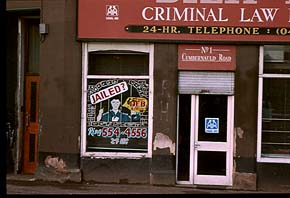 At the far end of the Parade, where the park ends, you come to Haghill, an area built later than the Parade and of poorer tenemented housing; here you feel you are struggling to keep your feet above the waters of the east end. This feeling is confirmed as you walk south down Cumbernauld Road towards Duke Street and overlook the lands towards Parkhead, once occupied by the chemical works, but now occupied by a bakery. A pub unashamedly proclaiming its sectarian alliegance and a Criminal Lawyer's office announces that even douce Dennistoun has its underbelly. I stooped to take a photo of the quaint mural in the lawyer's window. Out of the aforementioned pub staggered a punter, watching me curiously, then stating,
At the far end of the Parade, where the park ends, you come to Haghill, an area built later than the Parade and of poorer tenemented housing; here you feel you are struggling to keep your feet above the waters of the east end. This feeling is confirmed as you walk south down Cumbernauld Road towards Duke Street and overlook the lands towards Parkhead, once occupied by the chemical works, but now occupied by a bakery. A pub unashamedly proclaiming its sectarian alliegance and a Criminal Lawyer's office announces that even douce Dennistoun has its underbelly. I stooped to take a photo of the quaint mural in the lawyer's window. Out of the aforementioned pub staggered a punter, watching me curiously, then stating,
"He'll no get ye aff"
I asked for an explanation and found out that my new friend thought I was in need of legal aid, in relation to some unspecified offence, and recommended another pratictioner to me.
"He gets ivverybody aff," I was assured, and noted the fact for future use.
From Duke Street station Duke Street, the longest in Britain, stretches away east. Staying on the Dennistoun side of the railway is one world, but a few yards in the opposite, it is another. There are no waste plots in Dennistoun but as you head towards Parkhead you enter the third world of abandoned rubbish, waste ground occupied by dookits, and boarded-up and even burnt out housing. You can understand the desperation with which the respectable working classes sought to differentiate themselves from the underclass. To this day the sternest critics of the lumpenproletariat are the better-off working class.
Heading back along Duke Street this underworld is left behind , and we are passing again through well maintained shops and tenements. To the north of Duke Street at Whitehill Street was the home of another famous Glasgow entertainer, Dorothy Paul, whose Revelations of a Rejected Soprano tells of her upbringing in Dennistoun in the 1940s and 50s. This warm and amusing book tells of a mid 20th century working class upbringing and life, with sympathy and a lack of the sentimentalism so often an aspect of Glasgow sterrheed writing.
Dorothy went to Whitehill School in Dennistoun, which, before comprehensive education, was the senior secondary for a large part of Glasgow's east end. It is therefore unsurprising that it was the nursery of much popular talent, especially in the fields of entertainment and culture. Dorothy admits in her autobiography that she was not a model pupil, and her irreverent attitude to her teachers probably didn't help,
'We were waiting for the teacher to arrive when who should walk in the door but Tojo the Japanese war criminal. I thought he had been hanged, but no he was a maths teacher in Whitehill Senior Secondary.'
'Our (history) teacher was a ringer for John Christie the mass murderer. He drooled over blood and gore, and later "found God". He ended going around the streets of Glasgow making a cult of himself.'
Dorothy's career has had its ups and downs, and when after a difficult period, she had re-established herself, she returned to Whitehill to pioneer her first one woman show for the staff and pupils. I had been fortunate enough to teach Dorothy history when she was an outstanding mature student at Clydebank College and was also fortunate to be invited to this performance. And triply fortunate in that the comments on my teaching abilities in her book are thankfully less critical than those on her Whitehill history teacher. Aside from Dorothy, the school produced Lulu, Ricki Fulton the entertainer, Jack House the writer on Glasgow's history, as well as Adam Macnaughtan, composer of modern-day street songs, and Alisdair Gray, author of Lanark, and considered by many to be Scotland's greatest living writer, and the actor Bill Patterson. Quite a crop.
Dennistoun denizens have produced many autobiographies, and I have referred to some. (In fact they have produced more than any other area of the city, far ahead of Brigton and Gorbals, poor seconds.) Common themes emerge from perusing these. Most Dennistounians were the offspring of skilled or white collar workers. Dorothy's dad was an electrician, Jack house's a steelworks clerk, Rikki Fulton's was a locksmith (he first worked in Singers in Clydebank but later opened his own shop). Most also appear to have had "kirkie" upbringings; the Boys Brigade, the Church Choir etc. Apart from the inevitable involvement in the Co-Operative Society, few in Dennistoun appear to have had serious political leanings in an otherwise political city. Their lives were a far cry from the standard visions of Glasgow working class life - or mostly they were.
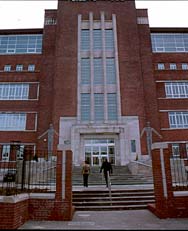 Once the Carnegie Library, built in the 1890s, appears on your right just off Duke Street you are back near your starting place, with Salmon's villas and terraces on that right side, and the tenements on your left. Here in Garfield Street was where Lulu lived, but her experience of Dennistoun was not happy - or typical. A little further on lie the ruins of the corporation abbatoir where her father worked; symbolically it straddles the railway line between Dennistoun and Brigton. For Lulu's dad was a drunkard and a wife-beater, as she makes clear in her autobiography. Further he was a part of the East End semi-criminal underworld, regularly stealing quantities of meat from the abbatoir and selling it to local butchers.
Once the Carnegie Library, built in the 1890s, appears on your right just off Duke Street you are back near your starting place, with Salmon's villas and terraces on that right side, and the tenements on your left. Here in Garfield Street was where Lulu lived, but her experience of Dennistoun was not happy - or typical. A little further on lie the ruins of the corporation abbatoir where her father worked; symbolically it straddles the railway line between Dennistoun and Brigton. For Lulu's dad was a drunkard and a wife-beater, as she makes clear in her autobiography. Further he was a part of the East End semi-criminal underworld, regularly stealing quantities of meat from the abbatoir and selling it to local butchers.
Adam Macnaughtan's song Cod Liver Oil and the Orange Juice describes an unsavoury character at the Dennistoun Palais; he gets unseemingly drunk and then behaves badly to a young lady. The song emphasises that he was not from Dennistoun,
Oot o the east there came a hard man
Oh, ho aa the wye fae Brigton.
Went intae a pub, came oot paralytic
Oh, ho V.P. and cider, a heeluva mixture
I feel sure that the inhabitants of Dennistoun would have looked disapprovingly at Lulu's dad, and ascribed his bad behaviour to his origins. And ascribed their own avoidance of such a fate to their good fortune in being raised in an area which, above all, valued and epitomised working class respectability.
For the vast majority of working people, even in "political" Glasgow, life was the pursuit of the calculus of differential advantage. The search was for a better job, for a better house in a better area, or betterment abroad. Apart from a minority who were politically engaged and committed, the mass of working people sought improvement - or escape, escape in entertainment, in sport as a career or as a supporter, in taking to the hills and mountains - or in engaging in a political career. Unions, the Labour Party and for a while the Co-ops offered social solidarity for working people, but also importantly career outlets for a minority of them as well. These political activities, or even joining the masons or the Kirk were forms of this incremental advantage. (In the slums and ghettoes, these aspirations were replaced by crime.) Dennistoun epitomises this search for improvement. No Mean Streets rather than No Mean City, that's Dennistoun.
This City Now
In recent years Ian has become very interested in urban walking, especially that on offer in his native Glasgow. Many articles in the website have come from this interest - Walks around Glasgow.
These were brought together in 2005 , with other pieces, in his highly-received work, This City Now: Glasgow and its Working Class Past (Luath Press).ISBN 1-84282-082-6 @ £12.99.
Available at all major book shops or Purchase at Amazon






